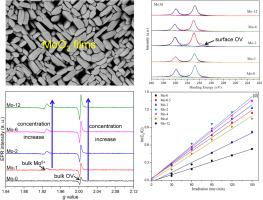Journal of Environmental Chemical Engineering ( IF 7.4 ) Pub Date : 2021-04-30 , DOI: 10.1016/j.jece.2021.105565 Yan Zhang , Xuecheng Ping , Liang Hao , Yiqiang He , Yongkang Guo , Qian Zhao , Zhaoqi Zheng , Yun Lu

|
Flexible MoO3-x films were prepared by anodic oxidation followed by annealing and liquid-phase reduction. The prepared samples were characterized by XRD, Raman spectra, SEM, UV-visible spectrophotometer, XPS, and EPR. The anodized amorphous MoO3 was transferred to the orthorhombic phase during the annealing. With the increase in annealing temperature, the MoO3 films’ photocatalytic activity increased. After liquid-phase reduction, defects, including oxygen vacancies, were introduced. The defect introduction enhanced the visible light absorption and increased the charge transfer efficiency to varying degrees. Compared with the as-annealed MoO3 films, the as-reduced MoO3 films’ photocatalytic activity rose by nearly four times at most. With the increase in reduction time, the bulk defect concentration increased. However, the surface defect concentration reached the maximum when the reduction time came to 2 h. The most excellent photocatalytic activity corresponded to the largest surface defect concentration, suggesting surface defects improved the photocatalytic activity. On the other hand, the bulk defects had the opposite effect. The photogenerated holes played a crucial role in the photocatalytic degradation of MB. Anodic oxidation followed by annealing and liquid-phase reduction is a facile and effective way to prepare MoO3 films with high photocatalytic activity.
中文翻译:

阳极氧化MoO 3-x膜的简便制备及其增强的光催化活性
通过阳极氧化,然后退火和液相还原制备柔性的MoO 3-x膜。制备的样品通过XRD,拉曼光谱,SEM,紫外可见分光光度计,XPS和EPR进行表征。在退火过程中,阳极氧化的非晶态MoO 3转移到正交晶相。随着退火温度的升高,MoO 3薄膜的光催化活性增加。液相还原后,引入了包括氧空位在内的缺陷。缺陷的引入增强了可见光的吸收,并在不同程度上提高了电荷转移效率。与退火后的MoO 3薄膜相比,还原后的MoO 3薄膜的光催化活性最多提高了近四倍。随着还原时间的增加,整体缺陷浓度增加。然而,当还原时间达到2 h时,表面缺陷浓度达到最大值。最优异的光催化活性对应于最大的表面缺陷浓度,表明表面缺陷改善了光催化活性。另一方面,体缺陷具有相反的效果。光生空穴在MB的光催化降解中起关键作用。阳极氧化,退火和液相还原是制备具有高光催化活性的MoO 3膜的简便有效方法。


















































 京公网安备 11010802027423号
京公网安备 11010802027423号